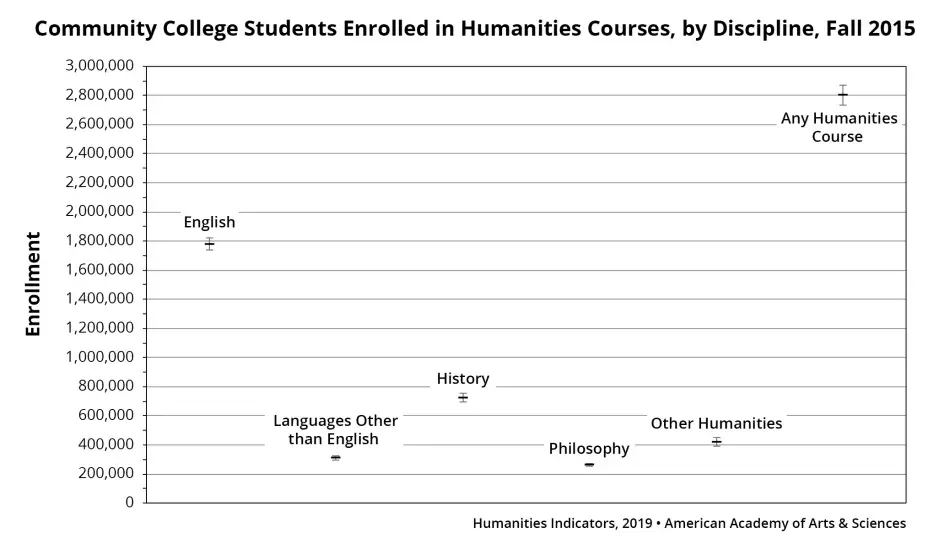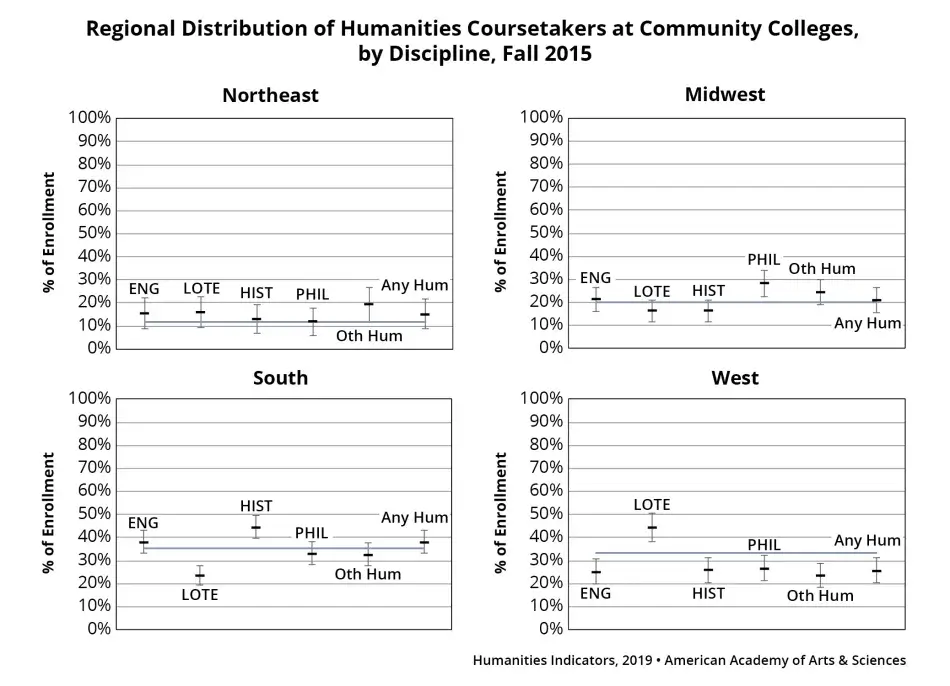Much of the attention about the humanities in higher education tends to focus on four-year colleges and universities (and more specifically, on the declining number of students who major in the humanities). In recent years, the American Academy’s Humanities Indicators (HI) have been exploring the growing presence of the humanities in the community college sector. To capture the scale and character of humanities education at these institutions, the HI (with funding from the National Endowment for the Humanities) surveyed the nation’s community colleges on three key topics:
- The number and share of students taking humanities courses;
- The number and share of faculty teaching such courses; and
- The number and share of students who earn college credit in the humanities while still enrolled in high school.
The findings underscore the significant presence of the humanities in community colleges and reveal some of the variations in humanities course-taking in this sector.
Students Taking Humanities Courses
One of the key goals of the survey was to determine how many students in community colleges are touched by the humanities. While an earlier HI study demonstrated that over 350,000 students earned associate’s degrees in the humanities and liberal arts in 2015,1 that finding tells us very little about the number of students in science or vocational tracks who might also take humanities courses. Though the survey could not identify the majors of the students taking the courses, it did find a substantial gap between the count of degrees and the number students in the classroom: the survey found approximately 2.8 million students took at least one humanities course at a community college in the fall of 2015.
A majority of those students (over 1.7 million) were taking at least one course in English, indicating a writing requirement at most institutions. The numbers in other humanities disciplines were substantially smaller, with approximately 700,000 students taking a history course; 300,000 students studying a language other than English (LOTE); and about 265,000 students enrolled in a philosophy course. Another 425,000 students took a course in a different humanities discipline or a survey course in the humanities. In all, approximately 40 percent of community college students were taking a humanities course in the fall of 2015, with one-quarter of the students who were enrolled in for-credit courses taking an English class.
While the topline figures highlight the vast scale of the humanities in community colleges, they mask some notable differences in the distribution of students taking those courses. For instance, some assume that community colleges that focus on preparing students to transfer to four-year institutions have a disproportionate share of students who take humanities courses. To the contrary, the survey found little difference when different types of institutions were compared, except in the shares of students taking language courses–which was higher among students at transfer institutions, and less prevalent at colleges with a career and technical focus. Regionally, students in the South appeared somewhat less likely to take humanities courses in general (and substantially less likely to take a course in languages other than English), while language courses were popular among students in the West.


High School Students Taking Humanities Courses
The survey also showed that high school students account for approximately 10 percent of students who take courses in the humanities at community colleges, though the share varied widely by discipline. High school students comprised more than 14 percent of the students enrolled in courses in English, history, and languages other than English, but less than 8 percent of the students taking philosophy and other courses in a humanities discipline.
Research indicates that individuals who participate in dual enrollment, which allows students to take courses for college credit while still enrolled in high school, are more likely to attend college, earn a higher grade-point average, and make swifter progress toward a college degree. Yet some humanities faculty at four-year colleges and universities worry that dual enrollment drives down the already dwindling number of students taking humanities courses at their institutions. While the survey cannot directly address the impact of dual enrollment, it does highlight the number and distribution of high school students taking humanities courses at community colleges.
Faculty Teaching Humanities Courses
Another goal of the survey was to determine how many faculty members teach humanities courses for credit at community colleges. The survey does not provide details about the demographics and employment status of the faculty, but it does show that approximately 70,000 faculty taught at least one college-level humanities course for credit at community colleges in the fall of 2015.
Faculty teaching humanities courses represented approximately 20 percent of all community college faculty, with faculty teaching English classes accounting for about 10 percent of the total faculty population (approximately 37,000). Between 14,200 and 14,900–or approximately 21 percent of faculty teaching humanities courses–taught classes in history; more than 11,000 faculty taught courses in languages other than English; and approximately 5,000 taught courses in philosophy.
One interesting finding from the survey data is that the student-faculty ratio for courses in the humanities was 40:1, as compared to 20:1 for all for-credit courses at a community college (when courses in vocational and nonhumanities subjects are included). Part of the difference may be the smaller classes for labs and vocational courses, but it might also reflect differences in personnel. Since the survey collected only head counts and not information about the employment status of the faculty, disciplines and fields that use a larger share of adjuncts would have deceptively smaller student-faculty ratios.
Future Research
The survey of humanities education in community colleges was a pilot project for the Humanities Indicators and follows two previous studies of humanities departments in four-year colleges and universities. Though the community college survey provided a unique window into the state of the field in this sector, it also highlighted the challenges involved in collecting data through the college institutional research offices instead of from the humanities departments themselves. Information on key questions–particularly the use of adjunct faculty–remains a lingering area of interest. The Humanities Indicators staff plans to return to the study of community colleges in coming years. As the survey demonstrated, any assessment of the state of the humanities in higher education must include two-year colleges.
For more information about the Humanities Indicators, please visit www.humanitiesindicators.org or contact Robert Townsend, Co-Director of the Humanities Indicators, at rtownsend@amacad.org.
Robert B. Townsend is Co-Director of the Humanities Indicators and Director of the Academy’s Washington, D.C., office.